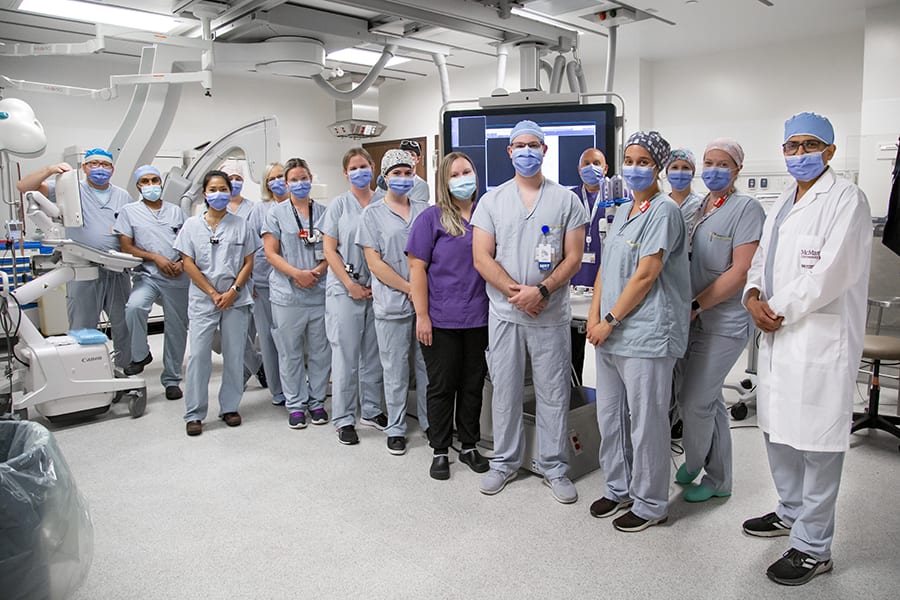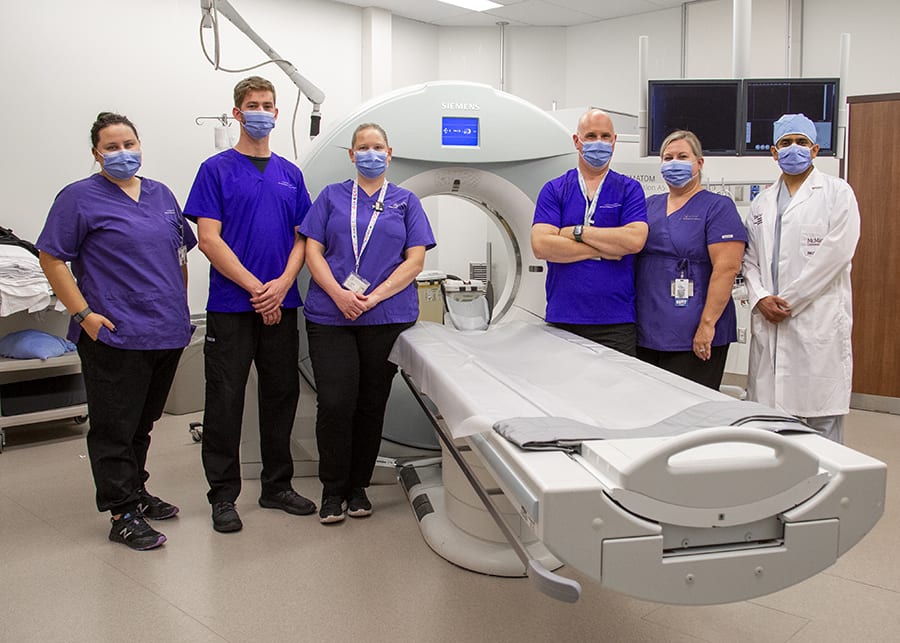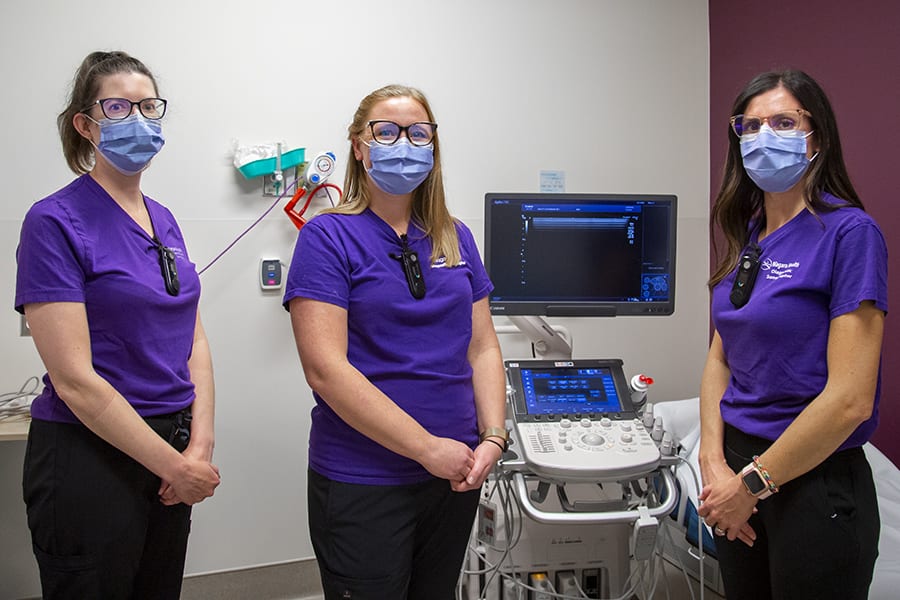Dr. Sriharsha Athreya noticed he was seeing a lot of patients from Niagara during his time as an Interventional Radiologist in Hamilton.
So when a job opportunity arose in Niagara Health’s Interventional Radiology Department in late 2017, Dr. Athreya didn’t hesitate to apply. He saw it as a chance to provide more extensive care closer to home for so many Niagara patients.
“I thought, ‘We see a lot of people from Niagara. I could help there,’” Dr. Athreya recalls. “I knew Niagara Health was welcoming, progressing and bringing change locally for patients.”
Interventional radiology (IR) is a specialty of radiology the uses medical imaging, including CT scans, fluoroscopy, MRI and ultrasound, to guide minimally invasive surgical procedures that diagnose and treat a variety of conditions. IR procedures include biopsies, inserting picc lines, angioplasty or stents to unblock blood vessels, and treating cancers with tumour ablation or through chemo-embolization, which restricts a tumour’s blood supply.
At the time of Dr. Athreya’s arrival, the department had two interventional radiologists working hard to serve patients during limited hours. If patients needed the care of an interventional radiologist overnight for conditions such as post-partum hemorrhages or abscess drainage, for example, they had to be transferred out of Niagara.
Soon after Dr. Athreya made the move to Niagara Health, he was promoted to Head of Interventional Radiology. The department added other fellowship-trained Interventional Radiologists, Diagnostic Imaging Nurses and Medical Radiation Technologists, and momentum grew to offer more services with support from Dr. Julian Dobranowski, Niagara Health Chief of Diagnostic Imaging, and Mike Sharma, Diagnostics Director.

Some of the Interventional Radiology team at Niagara Health. The department now has four fellowship-trained interventional radiologists, medical radiation technologists and nurses. Together, they help patients throughout their procedures, and assist with recovery and discharge.
Becoming a hub of world-class healthcare
In 2019, under Dr. Athreya’s leadership and with funding from Cancer Care Ontario, the department began offering image-guided tumour ablation, making Niagara Health one of the few Ontario hospitals to offer the service. This low-risk, pinhole procedure done under conscious sedation is used to treat small tumours on the kidneys, lungs or liver by using a superfine probe to burn or freeze the cancerous cells. Patients are discharged from hospital the same day.
“This is evidence-based, targeted treatment for cancer tumours, especially those under four centimetres,” Dr. Athreya says. “Previously, there were only a few centres in Ontario doing this, including Toronto, Hamilton and London. Now we’re proud to say we’re offering this treatment locally.”
During a routine ultrasound in 2019, doctors discovered a small tumour on Fern Gow’s right kidney. Fern, a retired Registered Nurse who lives in Niagara Falls, was given the choice of surgery, which would require the removal of part of her kidney, or tumour ablation through IR.
She opted for the latter after meeting with Dr. Athreya and researching the work he had done in the field previously.
“He was so approachable and very informative. I decided to go for it,” Fern recalls. “The program is great for people like me who don’t want to have surgical intervention and prefer something less invasive. I was really happy to have this done here in Niagara through a remarkably high-quality program by highly qualified professionals. If I had to go to Hamilton, it would have been more difficult.”
This November marks three years since Fern had the 60-minute procedure that left her feeling little pain and needing minimal recovery. She has been cancer-free ever since.
“I’m still here,” she says. “I hope it keeps going this way."

From left: Medical Radiation Technologists Carly Mascia, Brayden Shaw, Sarah Robb, Christopher Provias, Tiffany Sagloski and Dr. Sriharsha Athreya gather around a CT machine, which is used in some of the procedures performed by the Interventional Radiology department.
Thanks to the dedication of Dr. Athreya and the IR team, the department now has four fellowship-trained interventional radiologists, medical radiation technologists and nurses. Together, they help patients throughout their procedures, and assist with recovery and discharge.
The team also created a streamlined system to manage appointments and optimize patient care, including letting patients know ahead of time what to expect on the day of their procedure. This ensures appointments run on time and any cancellations are filled quickly to avoid backlogs. Post-procedure followup is co-ordinated through the IR Outpatient Consultation Clinic.
Interventional radiologists are now on call 24/7, eliminating the need to send patients to other hospitals after hours for IR treatments. The program expanded to treat patients at the Niagara Falls Site two days a week, which has helped shorten wait times for certain IR procedures.
“The work done by the entire Interventional Radiology team has been commendable, particularly during the COVID pandemic, and I am grateful to all of them,” Dr. Athreya says. “Now we can provide image-guided treatment for cancer in Niagara that is minimally invasive, safe and recovery time is only a few days with no long-term effect on the organ function of lung, liver or kidneys. By offering these services locally, it instils confidence in clinicians and patients, too. We aim to provide patient-centred care.”
Providing patient-centred care close to home
The work of Dr. Athreya and the IR team has touched nearly every program in the hospital.

From left: Diagnostic Medical Sonographers, Amanda Ouwendyk, Vanessa Vaicius and Marisa Boccia are part of the Interventional Radiology team.
They’re “a tremendous asset,” providing timely access to biopsies and putting in lines and ports to provide treatment and pain relief to patients, says Dr. Michael Levesque, Chief of Oncology. Dr. Athreya also checks in regularly with the team at the Walker Family Cancer Centre to ask what’s needed in an effort to improve services and continue providing high-quality healthcare.
“It took a person like Dr. Athreya and other practitioners to care and build a program. All of them believe in providing patients in Niagara with services you can find elsewhere,” Dr. Levesque says. “They want the program to be the best it can be. We want people to come here because our program is world-class, not just because it’s close to home.”
IR is key in the care of dialysis patients, as well. The department performs critical vascular surgeries and procedures, including angioplasties to keep arteries and veins of dialysis patients open when fistulas start to fail. These are “patient lifelines that allow dialysis to clean their blood,” says Dr. Danny Lagrotteria, Head of Service for Nephrology. So, too, are the long-term hemodialysis catheters the IR team puts in using fluoroscopy, which is a type of medical imaging that uses real-time, moving X-ray images inside a patient’s body.
“They do a lot for vascular access to support dialysis care,” Dr. Lagroterria says. “Without them and the success of that program, we would have to send patients to Hamilton. The availability of IR here has done a lot to improve the quality of patients’ lives.”
Doctor's focus on world-class care turns Niagara Health into one of few Ontario hospitals to offer specialized tumour treatment - Niagara Health
Read More

No comments:
Post a Comment